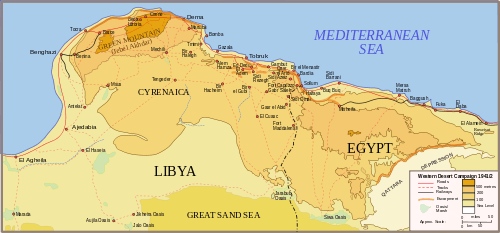64th Infantry Division Catanzaro
| 64th Infantry Division Catanzaro | |
|---|---|
| Active | 1939–1940 |
| Country | Italy |
| Branch | Italian Army |
| Type | Infantry |
| Size | Division |
| Nickname(s) | Catanzaro |
| Colors | red on left, black on right |
| Engagements | World War II |
The 64th Infantry Division Catanzaro was an Infantry Division of the Italian Army during World War II. The Catanzaro Division was created 3 June 1940 somewhere in Lybia and was destroyed 5 January 1941 in Bardia.
Action
Initially the Catanzaro division was deployed at Acroma to guard approach to Tobruk. The Italian invasion of Egypt started 9 September 1940, and 13 September 1940, the Catanzaro division was deployed facing the desert between Kambut and Sīdī ‘Aqūb Mas‘ūd in eastern Libya. but after the capture of Sidi Barrani on 16 September, the Italian Army formed a defensive line composed of big outposts separated by wide desert areas. Until 16 September 1940, the division moved gradually to Sidi Barrani to protect the coastal railroad.
On the nights of 7 December and 8 December 1940 the British Western Desert Force under the command of Major-General Richard O'Connor and comprising British 7th Armoured Division and Indian 4th Infantry Division reinforced by British 16th Infantry Brigade advanced a total of 70 miles (110 km) to their start positions for the attack.[1] The Catanzaro division at the moment was guarding the Buqbuq sector, north of 63 Infantry Division Cirene at Ābār Abū Safāfī (Sofafi), south of 1 Libyan Division Sibelle at Al Maktīlah (Maktila) and 2 Libyan Division Pescatori at ‘Alam aţ Ţummār (Tummar). The heavy bombardment and British armoured attack at ’Alam Rimth 9 December 1940 have penetrated the Catanzaro division defenses. The annihilation of the Maletti Group at ‘Alam Nibeiwa at the same day has aggravated the situation as well. Unable to resist or stop the attacks, the Catanzaro linked with other Italian units at Buqbuq and along the coastal railroad 10 December 1940, covering the retreat of 4th Blackshirt Division " 3 January" and the Headquarters for the "Libyan Corps" from Sidi Barrani.[2] By the 11 December Buqbuq had been cleared of all opposition and many Italain men and guns had been captured.[3] The remnants of division were able to make a stand at Bir Tishdida, at the eastern outskirts of Sallum, and contained British advance, at the cost of the majority of the remained Italian tanks.[4] 13–14 December 1940, the Catanzaro division under the relentless pressure retreated to Sallum proper, and 15 December 1940 have fell back to the defensive perimeter of Bardia.[5] What remained of the division was completely destroyed in the Battle of Bardia by 5 January 1941.

Order of battle
- 141. Catanzaro Infantry Regiment
- 142. Catanzaro Infantry Regiment
- 203. Artillery Regiment
- 64. Machinegun Battalion
- 64. Mixed Engineer Battalion
- 64. Antitank Company[nb 1][7]
- 20a Armor battalion
- 63a Armor battalion (transferred from 63rd Infantry Division Cirene 9 December 1940)
Notes
- Footnotes
- ↑ An Italian Infantry Division normally consisted of two Infantry Regiments (three Battalions each), an Artillery Regiment, a Mortar Battalion (two companies), an Anti Tank Company, a Blackshirt Legion of two Battalions was sometimes attached. Each Division had only about 7,000 men, The Infantry and Artillery Regiments contained 1,650 men, the Blackshirt Legion 1,200, each company 150 men.[6]
- Citations
- ↑ Playfair, p 266
- ↑ Macksey, p. 68
- ↑ Playfair, p 270
- ↑ http://www.comandosupremo.com/forums/topic/3744-italian-tank-bns-in-libya-and-egypt-operation-compass/
- ↑ http://www.regioesercito.it/reparti/fanteria/rediv64.htm
- ↑ Paoletti, p 170
- ↑ Wendal, Marcus. "Italian Army". Axis History. Retrieved 2009-04-24.
Sources
- Paoletti, Ciro (2008). A Military History of Italy. Greenwood Publishing Group. ISBN 0-275-98505-9.